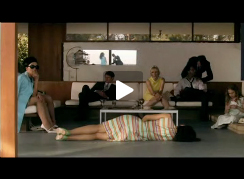Get the Flash Player to see this player.
Trailer for Eve Sussman & The Rufus Corporation’s single-channel video The Rape of the Sabine Women, 2007. Courtesy the artists and Roebling Hall.

Trailer for Eve Sussman & The Rufus Corporation’s single-channel video The Rape of the Sabine Women, 2007. Courtesy the artists and Roebling Hall.
Responses
DANGEROUS TO BEAUTIES: THE SABINE WOMEN, SYMBOLIC CONQUEST, AND CLASSICISM
Rebecca Zorach
Associate Professor, Art History, University of Chicago
The hand-held camera jumps and jerks; at full scale, it’s vaguely nauseating. We flash backward and forward: there’s grainy video of a stone face brutalized by the years, scenes of an idyllic place we do not yet know, references to things we’ve seen before, the sea. Sounds of shuffling feet surround us—and coughing, effortful grunts, keening voices, mechanical noise. From Berlin to the butchers’ stalls of Athens, disorientation doesn’t stop. Metal clashes, vendors call out against a buzz of nearly static, expectant sound, and women are dragged away—rag dolls that put up no resistance. With its knives slowly, rhythmically falling, the violence of the meat market does not reassure us that what the women leave behind is preferable to what they face. Read more…
IT SEEMS THAT THEY ALL WENT SWIMMIN’
Anthony Elms
Artist and Writer; Editor of WhiteWalls; Assistant Director of Gallery 400, University of Illinois at Chicago; Alumnus of the University of Chicago
On my first visit, intent on watching The Rape of the Sabine Women, a chanting ghostly voice dislocates my focus. “Them a woman was sobbin’, sobbin’, sobbin’” from Seven Brides for Seven Brothers (1954) directed by Stanley Donen. The musical film, set in the mid-nineteenth century American West, tells the story of a man who finds love, marries, argues with his wife, and must repair his marriage, all while he directs his six brothers in how to get themselves brides. The film is based on Stephen Vincent Benét’s short story The Sobbin’ Women, which is, of course, a crude adaptation of the Sabine Women myth. “Them a woman was sobbin’, sobbin’, sobbin’.” I swear it was there, bubbling forth from Jonathan Bepler’s score. Read more…















